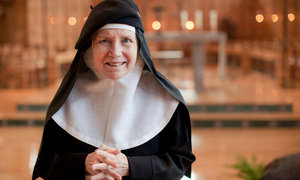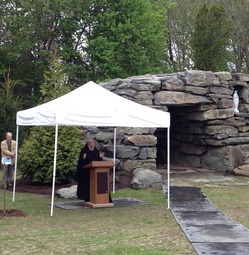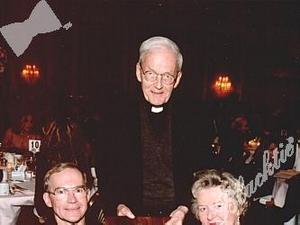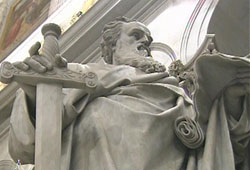Continue reading Portsmouth Abbey monks dedicate Lourdes Grotto
Category: Benedictines
Possible Olivetan abbot general?
 This young man may be elected the abbot general and the Abbot of the Abbey of Monte Oliveto Maggiore of the Olivetan Benedictines at some point. The abbot general is also appointed by the pope as the territorial abbot of this monastery, hence the magenta skull cap.
This young man may be elected the abbot general and the Abbot of the Abbey of Monte Oliveto Maggiore of the Olivetan Benedictines at some point. The abbot general is also appointed by the pope as the territorial abbot of this monastery, hence the magenta skull cap.
Portsmouth Institute announces the 2012 conference: “Modern Science, Ancient Faith”
The Portsmouth Institute is set to begin its third year of work from June 22-24, 2012, with the theme of “Modern Science, Ancient Faith.”
Matthew Leavy, abbot of Saint Anselm’s Abbey to retire after 26 years
 This is old news by now, and yet it bears keeping in mind that one of the world’s longest serving abbot, Benedictine Father Abbot Matthew Leavy, OSB, PhD, will retire as the 4th abbot of Saint Anselm’s Abbey in Manchester New Hampshire after 26 years of service to his monastic community, Saint Anselm’s College, and the Church in the Diocese of Manchester.
This is old news by now, and yet it bears keeping in mind that one of the world’s longest serving abbot, Benedictine Father Abbot Matthew Leavy, OSB, PhD, will retire as the 4th abbot of Saint Anselm’s Abbey in Manchester New Hampshire after 26 years of service to his monastic community, Saint Anselm’s College, and the Church in the Diocese of Manchester.
Abbot Luke Rigby, RIP
Earlier today I received news that an old friend died, Abbot Luke Rigby. Abbot Luke, 89, was the longtime religious superior of the monks at Saint Louis Priory –later Abbey– having come from England’s famed Ampleforth Abbey to live the Benedictine life.
Both Ampleforth and St Louis are Benedictine monasteries in the English Benedictine Congregation. In the USA Portsmouth and St Anselm’s (DC) are also of the English Congregation.
Dom Luke Rigby was appointed the Father Prior of his community succeeding Dom Columba Cary-Elwes in 1967; when the Priory granted independence by Abbot Basil Hume, Father Luke was elected the Conventual Prior by the community beginning in 1973. By grace St. Louis Priory was given abbatial status in 1989 and Prior Luke was elected its first Abbot; he served in this capacity until 1995. As the retired abbot of St Louis the English Benedictine Congregation bestowed on Abbot Luke the honor of being the Titular Abbot of Whitby.
Abbot Luke was a dear man; an insightful leader and a holy man of God. As monks say, he persevered in his vocation. I first met Abbot Luke in 1994 when I first went to St Louis for studies and then became friends with the monks there. Without fail I was received like a brother by Abbot Luke. Thanks be to God for all this.
Abbot Luke died peacefully this morning at Mercy Hospital after a long illness. His Mass of Christian Burial is Saturday, 24 March at Saint Louis Abbey.
From his biography at St Louis Abbey, it is written of Abbot Luke:
The life of this “ordinary fellow” (per his description) starts in London in 1923 in a Catholic family, through whom he is related to Saint John Rigby and other martyrs, priests, and religious of the Recusant period in England. He lived in suburban London in a Catholic environment until his father, a banker, was posted abroad. At this point Abbot Luke became a boarding student at Ampleforth College. He joined the monastery straight after high school.
Two items worth reading:
An Experience of the Eremitic Life: An Experience of the Eremitic Life by Luke Rigby.pdf
The Homily for Abbot Luke’s 50th Anniversary of Priesthood: Homily for Abbot Luke’s 50th Anniversary of priesthood.pdf
May God grant Abbot Luke mercy and may SaintsBenedict and Scholastica lead him to beatitude.
Saint John Rigby, pray for us.
Nun hits Hollywood, again: Mother Dolores Hart turns heads
 Benedictine nuns typically don’t go to the Oscars. For that matter, high profile actresses don’t consecrate themselves as Benedictine nuns. Dolores Hart did both.
Benedictine nuns typically don’t go to the Oscars. For that matter, high profile actresses don’t consecrate themselves as Benedictine nuns. Dolores Hart did both.
Continue reading Nun hits Hollywood, again: Mother Dolores Hart turns heads
Snow in Rome, Sant’Anselmo covered
Benedict: Our divisions diminish our witness to Christ…The goal of full unityis a secondary victory but important for the good of the human family
Dear brothers and sisters! It is with great joy that I extend my warm greetings to all of you who have gathered in this basilica for the liturgical Feast of the Conversion of St. Paul, concluding the Week of Prayer for Christian Unity, in this year when we are celebrating the fiftieth anniversary of the Second Vatican Council, that the Blessed John XXIII announced in this very basilica on January 25, 1959. The theme offered for our meditation in the Week of prayer which we conclude today, is: “All shall be changed by the victory of Jesus Christ our Lord” (cf. 1 Cor 15.51-58).
Hungary changes constitution, status of some religious orders changes in the law
At the new year the Hungarians passed a new constitution with some real changes that will affect the Church and other ecclesial communities, including non-Christian groups. The New York Times ran the article that outlines the changes giving the impression that even the Hungarians are unable to name all the changes. What caught my eye thanks to Brother Richard of OSB.org, when he first posted a note on his FB page that some venerable religious orders like the Benedictines and the Carmelites and a group like the Opus Dei are now downgraded in terms of the law. But why? What does the Hungarian government gain by doing such and what are the long-term implications for the Benedictines and Carmelites? Why weren’t the states of the Dominicans and Jesuits changed? Some of what happened is noted here:
“With the
new year, as the new constitution goes into effect, all petitions to the
[Constitutional] Court lapse and it becomes much harder for anyone to challenge
this law — or any other.
“But it is worth lingering on the newly
re-enacted law on the status of churches because it is one of the places where
we can clearly see the effects of the new constitutional order on the
protection of constitutional rights. What does the law on churches do? It
creates 14 state-recognized religions, and decertifies the rest. On January 1,
over 300 denominations lose their official status in Hungary — including their
tax exemptions and their abilities to run state-funded schools. While most of
the denominations are tiny, many are not. Among the religions that will no longer
be able to operate with state approval are all versions of Islam, Buddhism,
Hinduism and Baha’i, as well as many smaller Catholic orders including the
Benedictines, Marists, Carmelites, and Opus Dei, and a number of major
Protestant denominations including Episcopalians, Jehovah’s Witnesses, Seventh
Day Adventists, Mormons, Methodists, and all but one of the evangelical
churches. One each of the orthodox, conservative, and liberal Jewish synagogues
are recognized; but all other Jewish congregations are not” (The
Unconstitutional Constitution).
A Benedictine from Hungary writes
that “religious orders are still part of the Catholic Church in my country
and being as such they will maintain their legal status — all other
problematic constitutional points nothwithstanding.” (see OSB.org)
Create a space for silence, Bishop Hugh Gilbert tells us
Silence is misunderstood by so many people today. Some friends and family think that being silent is horrible, or that it is a punishment for something. Silence may have been used as a weapon, but in reality, it is not and silence ought not be used as such, ever. The new bishop of Aberdeen (Scotland), Hugh Gilbert, delivered his first pastoral letter on the subject of silence. As a Benedictine he is attune to the contours of silence as Saint Benedict exhorts followers of his Rule for Beginners to live in an atmosphere of silence. Could what Bishop Hugh offers be of assistance to us?
We live in a noisy world. Our towns and cities are full of noise. There is noise in the skies and on the roads. There is noise in our homes, and even in our churches. And most of all there is noise in our minds and hearts.
The Danish philosopher Kierkegaard once wrote: ‘The present state of the world and the whole of life is diseased. If I were a doctor and I were asked for my advice, I should reply: “Create silence! Bring people to silence!” The Word of God cannot be heard in the noisy world of today. And even if it were trumpeted forth with all the panoply of noise so that it could be heard in the midst of all the other noise, then it would no longer be the Word of God. Therefore, create silence!’
‘Create silence!’ There’s a challenge here. Surely speaking is a good and healthy thing? Yes indeed. Surely there are bad kinds of silence? Yes again. But still Kierkegaard is on to something.
There is a simple truth at stake. There can be no real relationship with God, there can be no real meeting with God, without silence. Silence prepares for that meeting and silence follows it. An early Christian wrote, ‘To someone who has experienced Christ himself, silence is more precious than anything else.’ For us God has the first word, and our silence opens our hearts to hear him. Only then will our own words really be words, echoes of God’s, and not just more litter on the rubbish dump of noise.
Continue reading Create a space for silence, Bishop Hugh Gilbert tells us







